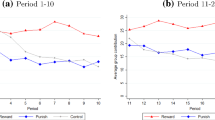Abstract
Pecorino (1998) models tariff lobbying in a repeated game and finds that cooperation can be maintained in a large group, even though tariff lobbying provides a rival public good to interest group members. We add small fixed costs of participation to this model and find that cooperation must break down in large groups. By contrast, if a fully rival public good directly enters the utility function, then cooperation is possible in large groups, even with small participation costs. Thus, we find only partial support for Olson’s (1965) proposition that collective action must break down in large groups.
Similar content being viewed by others
References
Andreoni, J. (1988). Privately provided public goods in a large economy: The limits to Altruism. Journal of Public Economics, 35, 57–73.
Cauley, J., Sandler, T., & Cornes, R. (1986). Institutional structures: Conjectures, distributions, and allocative efficiency. Public Finance /Finances Publiques, 41, 153–172.
Chamberlin, J. (1974). Provision of public goods as a function of group size. American Political Science Review, 68, 707–716.
Cornes, R., & Sandler, T. (1996). The theory of externalities, public goods, and club goods, (2nd edn): Cambridge, Cambridge University Press.
Dixit, A., & Olson, M. (2000). Does voluntary participation undermine the Coase Theorem? Journal of Public Economics, 76, 309–335.
Esteban, J., & Ray, D. (2001). Collective action and the group size paradox. American Political Science Review, 95, 663–672.
Friedman, J. W. (1971). A non-cooperative outcome for supergames. Review of Economic Studies, 38, 1–12.
Haag, M., & Lagunoff, R. (2003). On the size and structure of group cooperation. Manuscript, Georgetown University.
Hardin, R. (1982). Collective action. Baltimore: Johns Hopkins University Press.
Koppel, O. (2004). Public good provision in legislatures: The dynamics of enlargements. Economics Letters, 83, 43–47.
Lambson, V. E. (1984). Self-enforcing collusion in large dynamic markets. Journal of Economic Theory, 34, 282–291.
Lambson, V. E. (1987). Dynamic behaviour in large markets for differentiated products. Review of Economic Studies, 54, 293–300.
McGuire, M. C. (1974). Group size, group homogeneity, and the aggregate provision of a pure public good under cournot behavior. Public Choice, 18, 107–126.
McMillan, J. (1979). Individual incentives in the supply of public inputs. Journal of Public Economics, 12, 87–98.
Nitzan, S. (1991). Collective rent dissipation. Economic Journal, 101, 1522–1534.
Olson, M. (1965). The logic of collective action. Cambridge, MA, Harvard University Press.
Pecorino, P. (1998). Is there a free-rider problem in lobbying? Endogenous tariffs, trigger strategies, and the number of firms. American Economic Review, 88, 652–660.
Pecorino, P. (1999). The effect of group size on public good provision in a repeated game setting. Journal of Public Economics, 72, 121–134.
Pecorino, P., & Temimi, A. (2004). Olson’s logic revisited: The role of small fixed costs of participation. University of Alabama Working Paper No. 04-04-01.
Pecorino, P., & Temimi, A. (2006). The group size paradox revisited. Manuscript, University of Alabama.
Rodrik, D. (1986). Tariffs, subsidies, and welfare with endogenous policy. Journal of International Economics, 21, 285–299.
Sandler, T. (1992). Collective action. Ann Arbor, University of Michigan Press.
Shapiro, C. (1989). Theories of oligopoly behavior. In :R.Schmalensee & R. D.Willig (Eds.), Handbook of industrial organization, (vol. 1). North Holland: Amsterdam.
Author information
Authors and Affiliations
Corresponding author
Additional information
JEL Codes: D7, H4, C72
Rights and permissions
About this article
Cite this article
Pecorino, P., Temimi, A. Public good provision in a repeated game: The role of small fixed costs of participation. Public Choice 130, 337–346 (2007). https://doi.org/10.1007/s11127-006-9090-4
Received:
Accepted:
Published:
Issue Date:
DOI: https://doi.org/10.1007/s11127-006-9090-4




